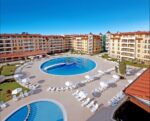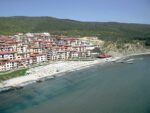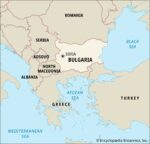Capital Charm: Learn all about Sofia, the capital of Bulgaria
Capital Charm: Learn all about Sofia, the capital of Bulgaria In the heart of Eastern Europe, among the giant peaks of the Balkan Mountains, lies Sofia, the capital of Bulgaria with a rich history and unique charm. This city, which has repeatedly experienced changes of epochs and cultures, today is a marvelous combination of antiquity and modernity. The streets of Sofia contain echoes of Roman emperors, traces of Byzantine temples and the spirit of the revitalized Bulgarian nation. Strolling through its picturesque squares and cozy parks, you will plunge into an atmosphere where every street whispers about its past. Let's discover together all the secrets and treasures that lurk in this magnificent city and understand why Sofia attracts the hearts of travelers from all over the world.
Table of Contents
- Historical Heritage: Architectural Pearls of Sofia
- Culinary Discoveries: Taste the traditions of Bulgarian cuisine
- Parks and Nature: Oases of tranquility in the heart of the capital city
- Contemporary Culture: Arts and Entertainment in Sofia
- Frequent questions and answers
- Conclusion

Historical Heritage: Architectural Pearls of Sofia
Sofia, as a city with a long history, delights its guests with architectural masterpieces that reflect the diversity of styles and eras. Strolling through the narrow streets of the capital, one can meet magnificent buildings, each of which tells its own unique story. Among the most famous landmarks are:
- Cathedral of St. Alexander Nevsky - The majestic church, built in the early 20th century, epitomizes the Orthodox faith and Bulgarian identity. Its golden domes glisten in the sun, attracting the eyes of locals and tourists alike.
- Roman ruins - still preserved structures from the ancient Roman period, which provide a glimpse into the past centuries and the spirit of the ancient world.
- Boulevard Vitosha - pedestrian zone where ancient architecture blends harmoniously with modern cafes and stores, creating a unique atmosphere of student life.
Another prime example of cultural heritage is National Art Galleryis located in the former royal palace. The building is characterized by Baroque features and its collection includes works by local and international artists. Also worth highlighting Church of St. SophiaIt is a masterpiece of Byzantine architecture, which gave its name to the city and became a symbol of the steadfastness and deep religiousness of the Bulgarian people.
| Architectural Masterpiece | Style | Year Built |
|---|---|---|
| Cathedral of St. Alexander Nevsky | Neo-Byzantine | 1912 |
| Church of St. Sophia | Byzantine | 6th century |
| National Art Gallery | Baroque | 19th century |

Culinary Discoveries: Taste the traditions of Bulgarian cuisine
Bulgaria's culinary traditions date back to ancient times, and every dish here is a work of art, with centuries-old secrets embedded in it. Bulgarian cuisine is based on fresh and natural ingredients, and each dish tells its own unique story. The most famous flavor highlights include:
- Serene - A salty cheese that is added to a variety of dishes and salads;
- Tarator - cold yogurt soup with cucumbers, peppers and garlic;
- Cufteta - Meat cutlets, often served with potatoes or fresh vegetables;
- Lutice -a spicy vegetable salad that complements any meal.
The culinary diversity is not limited to the main dishes. Pastries hold a special place in the hearts of locals and visitors alike. Try various desserts such as:
- Baklava - sweet pie with nuts and honey;
- Cherveno vino - We recommend to taste local wines, which are perfectly combined with Bulgarian cuisine.
| Dish | Ingredients |
|---|---|
| Smoked sausages | Pork, spices, smoke |
| Kapama | Meat, rice, greens |

Parks and Nature: Oases of tranquility in the heart of the capital city
Sofia, strangely enough, combines the dynamism of big cities with the harmony of nature. Many parks and green areas offer residents and tourists places for recreation and solitude. Popular locations such as Borisova Gradina Park и Sofia ZooIn addition to enjoying the fresh air, these spaces provide the perfect setting for walks, picnics and sports activities surrounded by beautiful scenery. In these spaces, you can not only enjoy the fresh air, but also watch people jogging, practicing yoga or just relaxing on the grass on a sunny day.
In addition, Sofia's green corners protect the diversity of local flora and fauna. Here are few of the marvelous features that can be found in these parks:
- Trees: Oak, chestnut and lime trees provide natural shade on hot days.
- Flora: Flowerbeds delight the eye with a variety of colors, especially in the spring.
- Fauna: Birds such as swallows and sparrows fill the parks with their melodious trills.

Contemporary Culture: Arts and Entertainment in Sofia
Sofia, being the cultural center of Bulgaria, offers many opportunities for art and entertainment lovers. The city abounds with modern galleries, theaters and concert venues that represent a wide range of creative fields. Some of the most notable venues worth checking out include:
- National Gallery of Art - home to a rich collection of Bulgarian and foreign art;
- Sofia Theater - A dramaturgy center with a variety of productions ranging from classical to avant-garde;
- Arena Armeec - the main venue for concerts of international stars and major events.
Don't forget the local music scene, which hosts folk festivals and contemporary festivals that reflect the country's diverse culture. To help you navigate the variety of offerings, here's a quick overview of popular events in the city:
| Event | Place | Date |
|---|---|---|
| Street art festival | City Center | July |
| Classical music concert | National Palace of Culture | September |
| Exhibition of contemporary artists | Screen Gallery | May |
Sofia thus combines tradition and innovation, making it an exceptional place to immerse yourself in the world of art and entertainment. The city attracts more and more tourists every year who are eager to experience its cultural life and unique charm.
Frequent questions and answers
Q&A: "Capital Charm: Learn all about Sofia, the capital of Bulgaria"
Question 1: Why is Sofia considered the unique capital of Bulgaria? Response: Sofia is not only the administrative center of the country, but also a city with a centuries-old history. It combines elements of different cultures and eras, from Roman ruins to the antiquity of Byzantine and Ottoman saints. It is a place where tradition neighbors with modernity, creating a unique charm.
Question 2: Which historical sights are a must-see in Sofia? Response: Sofia has many interesting sites, including the Alexander Nevsky Temple, one of the city's symbols, and the Rotunda of St. George, which is the oldest building in Sofia. Don't forget the National History Museum and the People's Assembly Square, which will give you a chance to immerse yourself in the country's rich history.
Question 3: What can be said about Sophia's culture and art? Response: Sofia is the cultural center of the country. It hosts various theater and music festivals, exhibitions of contemporary artists and exhibitions of traditional art. Institutions such as the National Opera and Ballet, as well as theaters, offer their visitors a rich program and high quality of performing arts.
Question 4: What kind of cuisine can I try at Sofia? Response: Bulgarian cuisine is unique and varied. You can enjoy dishes such as bannitsa (cheese and spinach pie), Shopski salad (salad with tomatoes, cucumbers and Bulgarian cheese) and kebapcheta (meat kebabs). Don't miss the opportunity to taste traditional Bulgarian wines and rakiya at local restaurants.
Question 5: What activities are popular among tourists in Sofia? Response: Sofia often hosts excursions to historical sites, cultural and musical events, and festivals dedicated to Bulgarian traditions and art. Outdoor seekers can enjoy hiking in the nearby Vitosha Mountains, which are only a few kilometers from the city.
Question 6: What is the atmosphere of life in Sofia like? Response: Sofia's atmosphere combines dynamic city life with elements of tranquility. Here you can find cozy coffee-scented cafes, green parks for strolling and bustling markets, where the spirit of Bulgarian hospitality can be found. The locals are friendly and open, which creates a special feeling of comfort.
Question 7: How to get to Sofia and get around the city? Response: Sofia is easily accessible by air, rail and road. The city's public transportation system, including metro, streetcars, and buses, is efficient and relatively inexpensive, making it possible to get around the city quickly moving. Sofia also has many cab and carsharing services for those who prefer comfort.
This article leads you into the world of Sofia's metropolitan charm, where every stone holds its own story. Come and experience this splendor for yourself!
Conclusion
Sofia is not just the capital of Bulgaria, but a place where history meets modernity and cultural multiplicity fills the streets with life. Nestled beneath the snow-white peaks of Vitosha, cozy cafes and stately buildings invite you to immerse yourself in the capital's charm. We hope our article has helped you learn more about beautiful Sofia, its rich heritage and unique attractions. Discover this corner of the Balkans and perhaps Sofia will be the next step in your journey around the world. Don't miss the opportunity to enjoy its indescribable beauty and the warmth of the locals - there is something for everyone. Welcome to Sofia!












